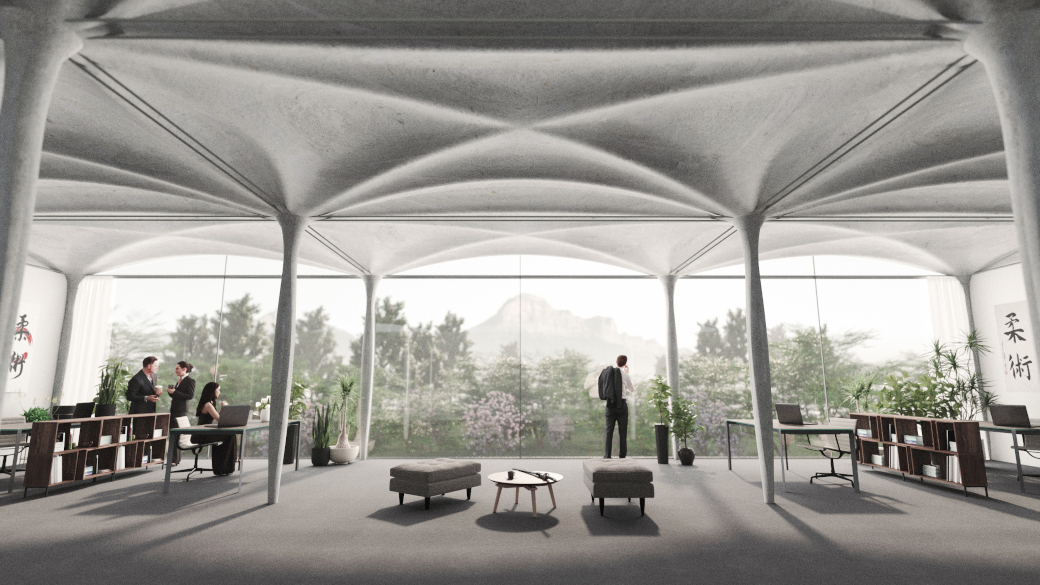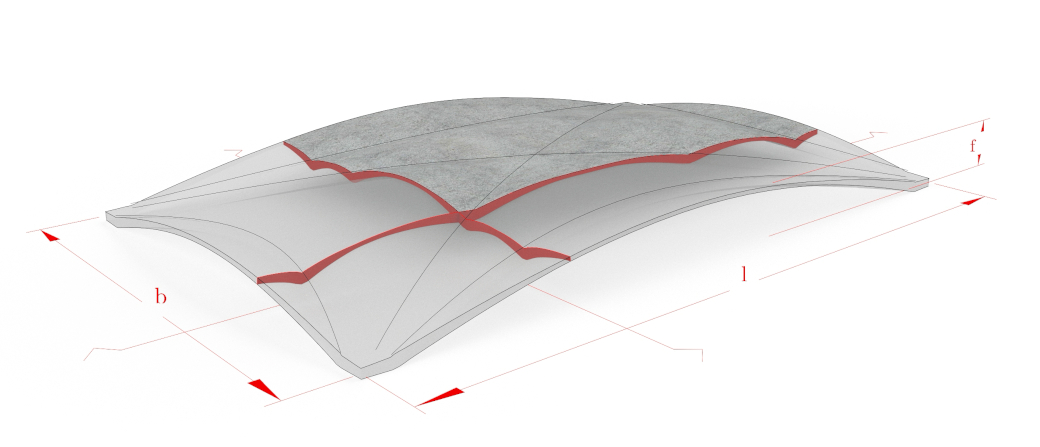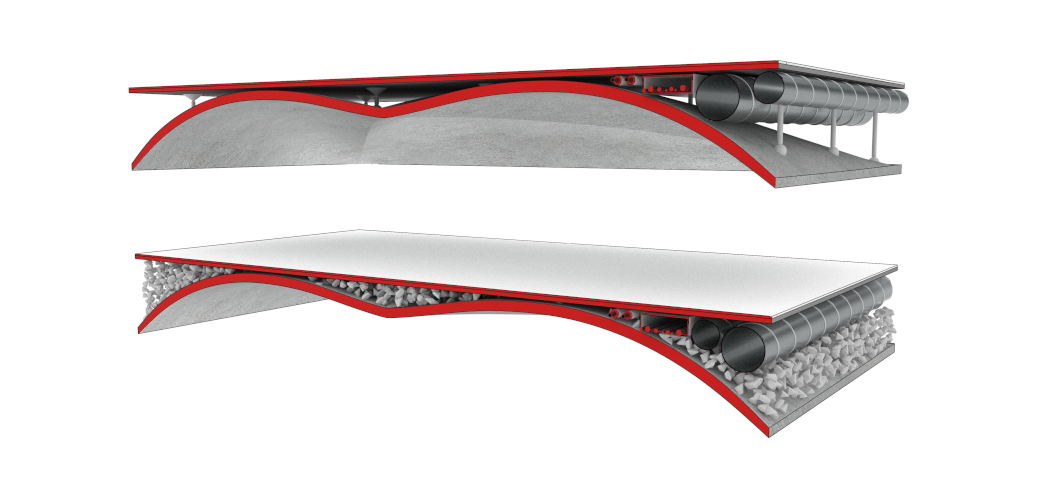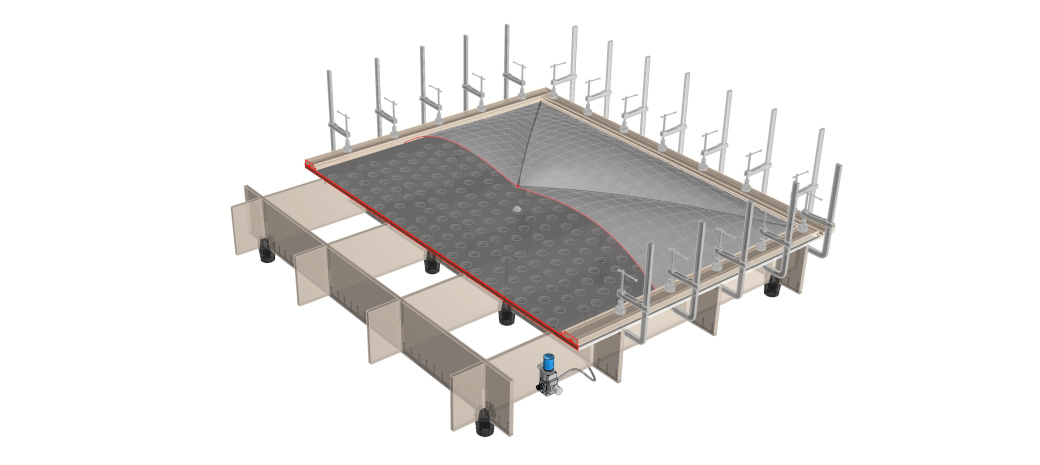V-Form – Manufacturing unreinforced vaulted concrete floors with variable pneumatic formworks
Short Description
Starting point / motivation
The construction sector is responsible for most global CO2 emissions - around half are caused by production and transportation. In buildings, the majority of these can be attributed to the supporting structure, in particular floor slabs, which represent the largest lever for reducing emissions, as they amount to approx. 40% of the building mass.
Concrete vaulted ceilings promise a significant material reduction due to their effective shell construction and load transfer via membrane stresses. The predominant compressive stress state results in a uniform stress distribution along the cross-section and thus loads can be transferred in accordance with the properties of concrete - i.e. high compressive strength, low tensile strength. This saves large quantities of building materials.
Initial studies on pneumatically manufacturable vaulted floors indicate a reduction in CO2eq emissions of -70% compared to conventional reinforced concrete flat slabs. Even further reductions can be achieved by using recycled aggregates, considering the effect of carbonatation and reduced transport emissions.
Due to the compressive stress state, the shell can also be constructed without steel reinforcement, which has a positive effect on the life cycle assessment of these floors, as steel has around 8 times higher mass-specific emission values than concrete. The vaulted floors are therefore reusable, recyclable and the service life of the component is significantly extended by eliminating the corrosion of the reinforcement.
However, formwork structures are very complex to manufacture due to their double-curved surface. Formwork with an equally complex geometry must first be produced and this is associated with high manufacturing costs. The formworks are also usually not reusable, unsustainable and uneconomical.
Contents and goals
This project aims to solve these challenges by developing a reusable and geometrically variable pneumatic formwork system for vaulted floor structures. The advantageous properties of pneumatic membrane formworks are utilized, as they approximate the theoretically optimal shell geometries very well – in the case of a small rise of the shell and can be used as formwork for concrete shells.
The usually high formwork costs necessary to produce double-curved concrete components can thus be reduced. The desired shell geometry is achieved by precisely controlling the inflation of a membrane using various sensors. Furthermore rib-like features are achieved by tensioning the membrane with cables, avoiding a secondary formwork. These ribs improve the structural behavior of the shell under asymmetrical load cases.
The flexible properties of membranes also enable the geometrically variable production of the concrete shells. Floor elements can be bespoke manufactured for varying geometric requirements - span, floor plan, rise, support conditions - using the same formwork system. The formwork membrane is only held in the desired geometry via over-pressure until the concrete cures and can then be reused for other shell geometries.
Methods
In addition to investigations of the shape optimization of pneumatically produced vaulted floors and their building physics aspects, the V-Form project will also focus on developing the production method. Although pneumatic formworks offer enormous advantages, they can only be utilized if sufficient and repeatable production accuracy is achieved, as well as a low production workload.
The greatest challenge in this regard is the soft and therefore flexible formwork membrane. In contrast to conventional rigid formworks, unwanted deformations and therefore inaccuracies can occur during placement of the concrete. Solutions to this problem are developed in the research project with pneumatic formwork prototypes and carrying out tests regarding concrete technology.
We want to contribute to sustainable and circular construction with the development of a reusable, geometrically variable formwork system for vaulted floors.
Project Partners
Project management
Institute of Architectural Sciences - TU Vienna
Project or cooperation partners
- Institute of Material Technology, Building Physics, and Building Ecology - TU Vienna
- Werner Sobek - non nobis
Contact Address
Dipl.-Ing. Rudolf Neumerkel
Karlsplatz 13/259-2
A-1040 Vienna
Tel.: +43 (664) 198 5341
E-mail: rudolf.neumerkel@tuwien.ac.at
Web: iti.tuwien.ac.at




